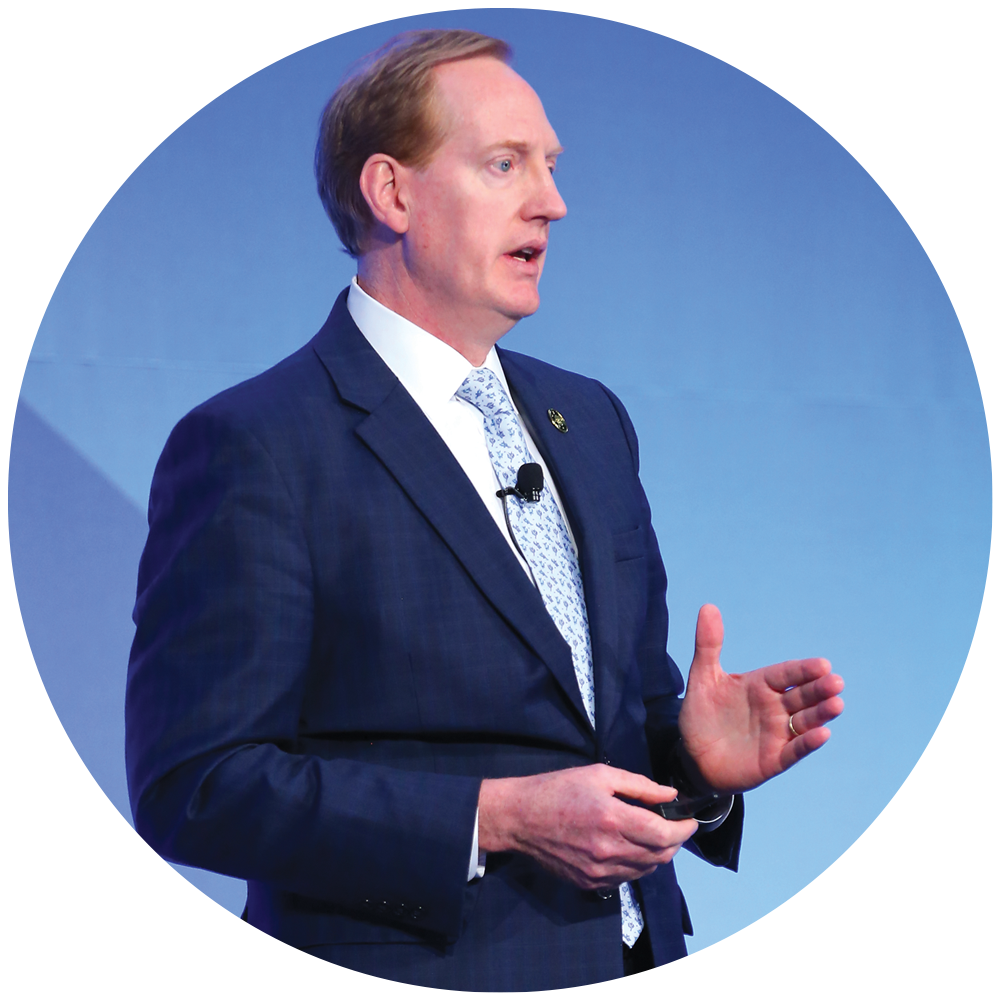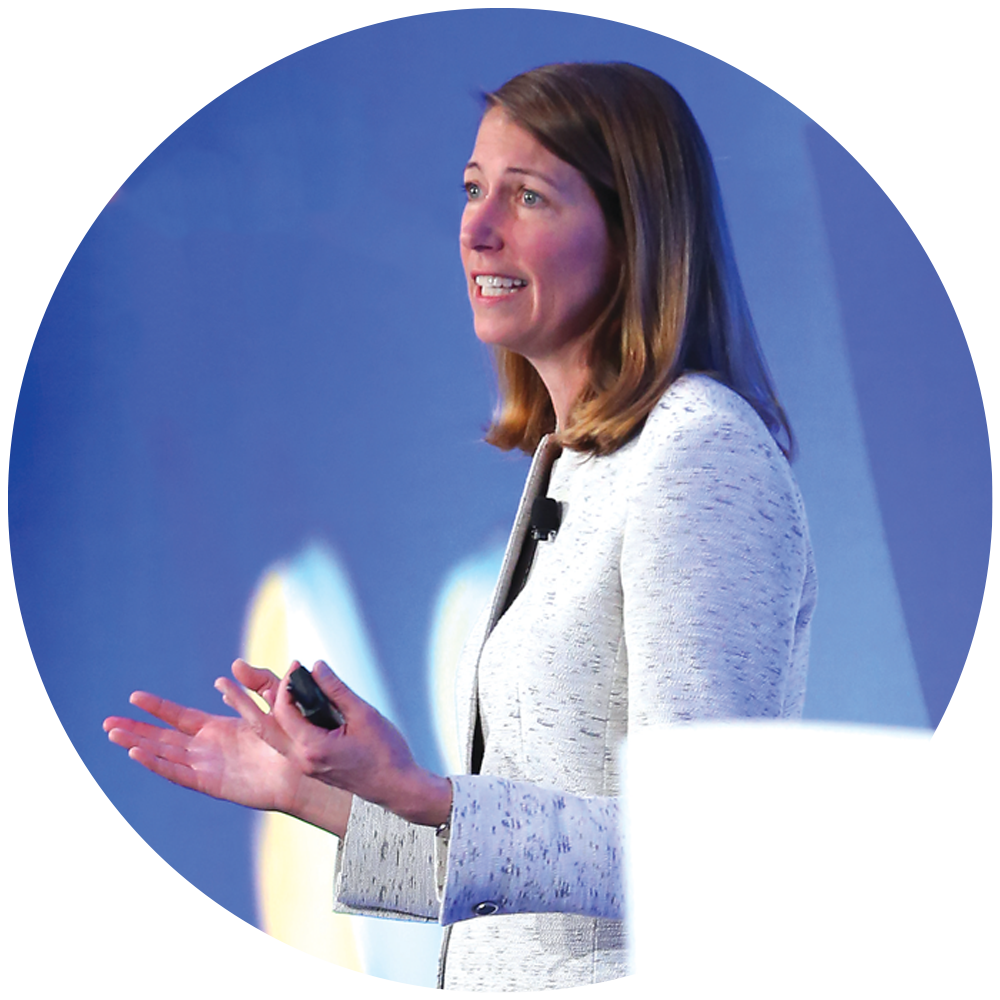 Faced with continued disruption, the convenience and fuel retailing industry needs to make a choice: Stick with a decades-old business model or evolve to capture the imaginations and loyalty of ever-changing consumers. That was a key takeaway from the 2019 NACS State of the Industry Summit, held April 2–4 in Chicago.
Faced with continued disruption, the convenience and fuel retailing industry needs to make a choice: Stick with a decades-old business model or evolve to capture the imaginations and loyalty of ever-changing consumers. That was a key takeaway from the 2019 NACS State of the Industry Summit, held April 2–4 in Chicago.
“When we hear about disruption, that shouldn’t sound scary. It should make us think about opportunity,” Andy Jones, NACS vice chairman of research and president and chief executive officer of Sprint Food Stores Inc. of Augusta, Georgia, told Summit attendees. “Evolve is a key word,” he said.
More than 600 leading retail and supplier company representatives gathered in Chicago for the industry’s top conference for benchmarking and analysis of retail trends. NACS State of the Industry (SOI) data took center stage. The overall financial picture is a positive one, as U.S. convenience stores notched a 16th-straight year of record in-store sales in 2018. Sales overall rose 8.9% to $654.3 billion, led by a 13.2% increase in fuel sales, which accounted for 69.6% of total sales.
Get your team to think 10 years ahead. Think of the consumer 10 years from now and work backwards.
A deeper dive into the numbers, though, shows continued headwinds. Consumers are making fewer trips; the cost of growth is increasing as store operating expenses climb amid a tight labor market that is pressuring wages and rising credit card fees that are biting into profits; and a quickened pace of store consolidations and competition from dollar stores, Amazon Go and online delivery services make for challenging times in the industry. Expansion into foodservice—or ramped up offerings to meet consumer demands for variety—means bigger stores but also the accompanying operating expenses to accommodate that growth.
It’s those headwinds that the conference presenters tackled during the two-day event, and attendees had ample time for ensuing discussions about overcoming them during the networking breaks and evening receptions. The keywords “disruption” and “friction” peppered most presentations. The idea of moving from the old-store model of “gas, Cokes and smokes” to a new model of reduced friction—think self-serve kiosks and loyalty-centric phone apps, as well as delightful convenience-store experiences, Wi-Fi lounges and uniquely local goods—took centerstage.
Billy Milam, chief operating officer for RaceTrac Petroleum and NACS Research Committee member, noted that other retail channels are redefining the idea of convenience, which is affecting the c-store industry. He cited Amazon CEO Jeff Bezos’ goal of opening 3,000 Amazon Go cashier-less stores in the next three years. “If they can pull this off, they will become the fourth-largest convenience store group in our industry,” Milam said. “They are retraining the customer.” No lines, no cash and no interaction with a store clerk makes for a relatively frictionless experience.
All the while, dollar stores continue to encroach on c-store territory, especially in the eastern U.S. Seven years ago, Milam said, Dollar General and Family Dollar didn’t sell beer, wine or tobacco. Now they do—and some stores are experimenting with gasoline sales. “These companies are coming into our market on our turf and capitalizing on what we’ve done. This is one of those weak signals that I want you to focus on.”

What's Cool? These Top Products...
This year’s event showcased 106 Cool New Products. Similar to the NACS Show, attendees received a scanner to scan their favorite products for follow-up after the event. Here’s what landed in the top spots (with a three-way tie for second!) and captured the attention of this year’s Summit attendees:

Trends That Matter
Todd Hale, former senior vice president, consumer and shopper insights, Nielsen and now principal of Todd Hale LLC, in Cincinnati, Ohio, encouraged SOI Summit attendees to look for growth opportunities amid the disruption. “What does the future look like?” Hale asked. “Are you managing threats and opportunities?”
He noted that store sales are soft as unit sales are flat, but growth in the perimeter continues. Private-label brands are winning as consumers' tastes change—they want health and wellness products but also indulgent ones.
U.S. store counts, including convenience stores, are down in all channels but the dollar store and liquor formats. Drugstores and convenience stores drove the contraction in U.S. store counts. Nearly 2,200 single-store operators of convenience stores closed in 2018, according to the NACS/Nielsen TDLinx Census. “Traffic patterns change; businesses come and go,” Hale said. Chain-store operators, in particular, need to be strategic about managing store closings. “How do you fuel investments into locations that can really drive results for you rather than some of those weaker locations?”
We are the first mile; we are the last mile for consumers. Technology plays a huge role in what we do.
Competition for the traditional c-store customer is happening on several fronts. West Des Moines, Iowa-based supermarket chain Hy-Vee, for example, packs made-to-order meals; wood-oven pizza; sushi; meal kits; and fresh produce, meat, dairy and bakery products in a 10,000-square-foot convenience-store format that also offers a Starbucks counter, gasoline sales and grocery pickup.
Target is focusing on small format stores in urban areas, with plans to open a dozen or more new-format stores each year in cities and on college campuses. And its acquisition of Shipt has helped it expand two-day-or-less delivery of goods. Dollar General’s DGX Stores are about half the size of traditional Dollar Generals and offer a product selection tailored to urban dwellers, particularly millennials.
“Here’s an opportunity for you,” Hale said. “Drugstores are having a challenge with front-of-the-store sales,” with CVS moving toward a health-care-focused model over its traditional front-of-store assortment of products as people are making fewer trips to drugstores due to longer prescription refill periods and mail-order delivery. “C-stores should be ready to take over this,” he advised.
E-commerce sales continue apace, while brick-and-mortar store closings mount. “We’ve seen just as many store closings through March as we had in 2018. Some retailers are not keeping pace with some of the innovation going on in the marketplace," Hale said.
What’s selling? Most fresh departments are leading growth across the retail sector. Deli, seafood, floral, meat and bakery are all on the upswing. Health and beauty products also are strong performers, with private-label brands taking off. These could be opportunities for c-stores to innovate in their own lineups.
 Charlie McIlvaine, chairman and CEO of Coen Oil Co., shared SOI data on key categories and foodservice.
Charlie McIlvaine, chairman and CEO of Coen Oil Co., shared SOI data on key categories and foodservice.
A Blockbuster Shift
Charlie McIlvaine, chairman and CEO of Coen Oil Co., used Darwin’s survival of the fittest theory as a springboard to encourage attendees to adapt to change. A focus on selling beer and tobacco is no longer a winning formula for growth. Instead, stores need to focus on food, customer engagement and technology. “Regardless of income, people like to have a connection. How can we engage with that consumer and then learn from it?” he asked.
Cannabidiol (CBD) products are poised to take off if the FDA provides clarity on whether or not edible CBD products are permissible under marijuana’s current classification at the federal level as a Schedule 1 controlled substance. Given the c-store industry’s longtime experience with tobacco sales, McIlvaine said that “We are probably the best retail outlet out there to do age verification.”
What happens if the industry doesn’t evolve? McIlvaine posited. “RadioShack is a clear example of failure to adapt,” he said. After a series of missteps, losses and bankruptcies, today, RadioShack in the U.S. operates mainly as an e-commerce website with revenue far below $1 billion. Likewise, Blockbuster Video invented video streaming but rebuffed overtures from Netflix to combine, eventually undergoing bankruptcy and liquidation.
As the country’s largest channel of trade, accounting for a third of all brick-and-mortar stores, convenience stores should embrace technology and data-mining, McIlvaine told Summit-goers. “That is a huge repository of information. We are the first mile; we are the last mile for consumers. Technology plays a huge role in what we do.
“We have a track record of being relevant and evolving,” he said, “but we cannot rest on our laurels.”
Along with learning about the latest industry data, attendees were given the opportunity to network.
 Jason Lobel, CEO and co-founder of SwiftIQ, discussed the need to measure key performance indicators for promotions.
Jason Lobel, CEO and co-founder of SwiftIQ, discussed the need to measure key performance indicators for promotions.
Effective Promotions
In an era of declining trips, Jason Lobel, CEO and co-founder of SwiftIQ, a retail analytics software company, emphasized how data-based product promotions can help drive c-store sales. Receipt-level data are crucial for gauging the success of promotions, Lobel said. “Ask yourself if you have a good handle on funding and promotions,” he said. “If the answer is ‘No,’ it may be because you’re using the wrong measurement tools for the modern world.”
Promotions can help spur c-store sales in struggling categories, which include cigarettes, packaged beverages, beer, snacks and candy. “What we’re seeing is that shoppers are buying less categories and units per trip,” he said. “We want them to do the opposite.”
Once promotions are in place, pay attention to key performance indicators. These include unit and total dollar sales and average price, total basket units and price, take rates, source of volume, relative performance (vs. other brands, categories or stores), margin dollars, return on investment and base vs. incremental lift, Lobel said. Other key things to consider are how long the promotion runs, changes in shopper behavior (did they convert to a new brand, category or segment), the importance of signage and the timing of the promotion.
Food bundles and meal deals, tactical displays, such as placing a modular ice bin for sodas near the register on pizza Wednesday, and first-to-market innovations like e-cigarettes are working in the convenience-store space, Lobel said. What isn’t working? Promotions that aren’t supported with signs, too many promotions, small temporary price cuts and item bundles with opposite dayparts. “High margins are correlated with dayparts,” he said. “Sandwiches and canned drinks are 50% more likely to be purchased together, while candy and coffee are 55% less likely to be purchased together.”
 Laurie Demeritt, CEO, the Hartman Group, urged SOI Summit attendees to provide "an element of delight" to forge an emotional connection with consumers.
Laurie Demeritt, CEO, the Hartman Group, urged SOI Summit attendees to provide "an element of delight" to forge an emotional connection with consumers.
Delightful Convenience
Convenience store shoppers are still looking for an easy fill-up at the pump, a favorite snack and maybe something to take to the job site to eat later. Increasingly, though, they are looking for all of this plus an emotional connection or experience, according to Laurie Demeritt, CEO of the Hartman Group, who shared findings from the latest NACS/Coca-Cola Retailing Research Council (CCRRC) study examining the changing needs of convenience store shoppers: “Embracing Modern Convenience: Responding to Shopper Needs.”
“Consumer needs are changing and changing at a more rapid pace than they have in the past, and that’s caused a lot of consternation in the retail landscape,” Demeritt told Summit-goers. “There’s a lot of retail blurring going on,” but “that retail blurring is actually a real positive” because “it’s opening up the consumer to new ways to think about your channel.”
One way to do that is to provide what Demeritt calls “an element of delight,” whether that’s offering new and unique flavors of foods and beverages, fresh ingredients so consumers can finish creating meals at home, or in-store gathering spots that help form an emotional connection that keeps a store top of mind.
For more from the report, visit www.ccrrc.org.
 Jim Lecinski, author of the book Winning the Zero Moment of Truth, talked about how winning brands create great retail environments that reduce friction points.
Jim Lecinski, author of the book Winning the Zero Moment of Truth, talked about how winning brands create great retail environments that reduce friction points.
Assistive Digital Experiences
Making those emotional connections with consumers requires great brands. On day two of the Summit, Jim Lecinski, associate clinical professor of marketing at Northwestern University and a visiting professor in Notre Dame University’s executive MBA program, tackled branding in the digital age.
Quoting Harvard’s Clay Christensen, Lecinski reminded attendees that “Consumers hire your brand to do a job for them.” And increasingly, that job requires retailers to reduce friction—or pain points—at every step of the way. How consumers experience a brand depends on how well it assists them in getting their jobs done without friction. “It’s not good enough to be assistive and friction-free in just one point of interaction but at every point along the way,” Lecinski said.
To deliver that experience, retailers must:
- Create a great retail environment. “I need to get in and out as soon as possible,” Lecinski offered.
- Drive people into your destination. “Tell me that you exist. Guide me to your store location in a frictionless or relatively frictionless way.”
- Deliver a great experience. A brand needs to satisfy curiosity, understand demands and relieve impatience.
The “monkey wrench” in this equation is mobile, he said, because it’s changed how consumers shop. Consumers research everything now before they buy. Even “the mundane, everyday items are now being researched and compared on a daily basis” because that’s what consumers are used to doing with big ticket items. “While they’re waiting for the gas pump to fill this is what they’re doing,” Lecinski said. There’s been a more than 85% increase in mobile searches for “where to buy” a certain product between June 2015 and June 2017, he noted.
Add to this the fact that impatient customers are the norm. “For many of you, you are in the business of relieving impatience. You’ve been successful at relieving impatience, but the bar gets higher and higher.” People want same-day deliveries; they make last-minute decisions about where to eat, where to travel, what’s open. So, a slow-loading website can drive them away—anything more than two seconds, and visitors start abandoning a site.
Gray Taylor, executive director of Conexxus, stressed that to compete in the digital future, companies need to understand the value of data and use it to help drive profits.
Competing in the Digital Future
To cap the Summit, Gray Taylor, executive director of Conexxus, a nonprofit tech organization that develops and implements tech standards and innovations for the c-store industry, discussed how the industry must compete in the not-so-distant digital future. He laid out five key concepts that he believes will happen during the next five years, including one notion that seemed to strike a chord with the audience—every business is in the convenience business. “Frictionless is now the benchmark of convenience,” Taylor said.
Another key concept, according to Taylor, is that every business will be in the data business, and data will grow exponentially. “Companies with data-centric cultures will dominate profit pools,” said Taylor. “Technology is easy. Culture is really difficult.” Taylor encouraged business leaders to get their employees to understand the value of data. “Get your team to think 10 years ahead,” he said. “Think of the consumer 10 years from now and work backwards.”
Taylor also told the audience to not be afraid of being a disruptor. He pointed to the ultimate example of a disrupted market—the online marketplace’s dominance over department store sales. Audience members saw the 20-year rise and decline of department store sales in a graph, while Taylor pointed to times where the stores “failed to see” the rise and potential impact of the online marketplace and also where they “failed to believe” the online marketplace could abolish their stores.
The c-store industry should learn from the department stores’ failures, he said, by developing technology and adapting to a digital future, so they can not only keep up with the Amazons of the world but also thrive in the current landscape. “We’ve got time to do it. We’ve got to see, believe and respond.”
And Still More...
Other speakers offered additional insights, including:
- Anirban Basu, chairman and CEO of Sage Policy Group Inc., discussed the current economic climate and what we can expect in the areas of employment, wages, housing and retail sales.
- Tom Kloza, global head of energy analysis for Oil Price Information Service (OPIS), offered insights into future fuel prices in his session, “Behind the Fuel Numbers: Renaissance or Dark Ages.”
- Jim Knight, a 30-year training and development veteran and former head of training and development for Hard Rock International, talked about developing a culture that rocks. He revealed realistic solutions for systemic change, touching on areas such as defining culture, understanding the difference between heritage and culture, designing cultural collateral and employee engagement.